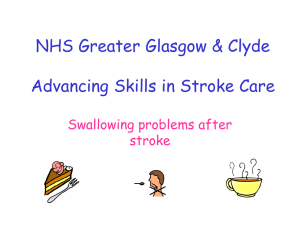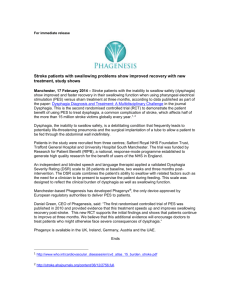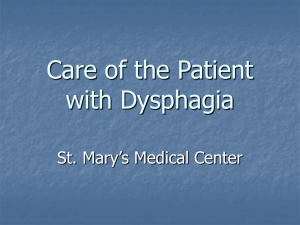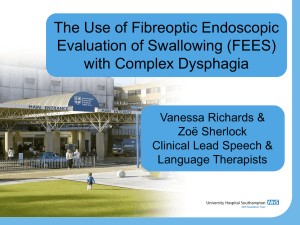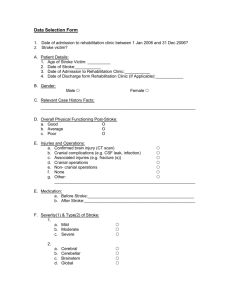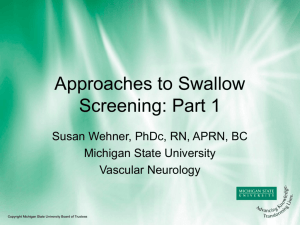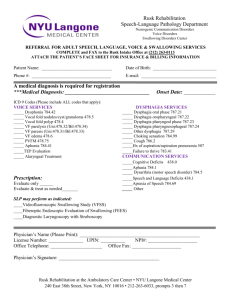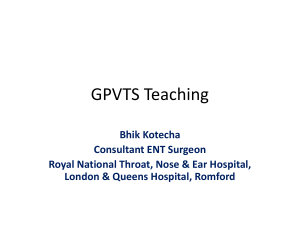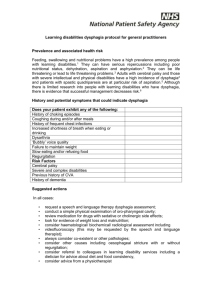Dysphagia Screen
advertisement
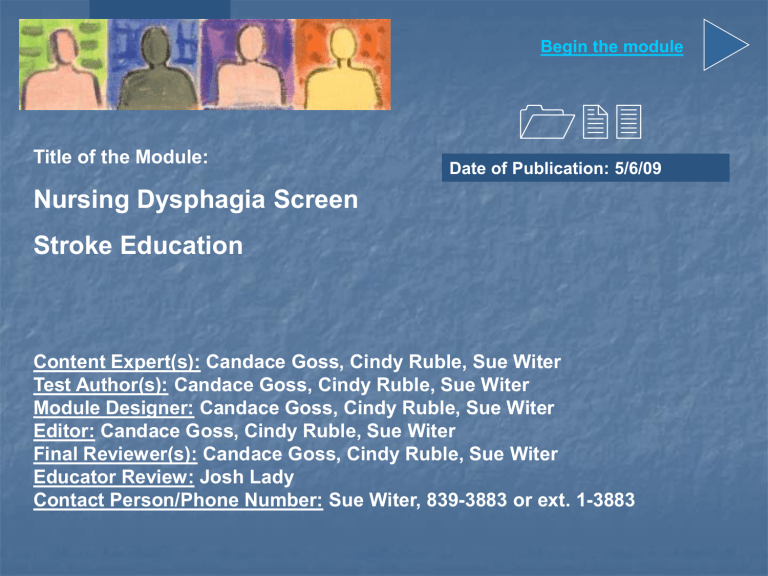
Begin the module 123 Title of the Module: Date of Publication: 5/6/09 Nursing Dysphagia Screen Stroke Education Content Expert(s): Candace Goss, Cindy Ruble, Sue Witer Test Author(s): Candace Goss, Cindy Ruble, Sue Witer Module Designer: Candace Goss, Cindy Ruble, Sue Witer Editor: Candace Goss, Cindy Ruble, Sue Witer Final Reviewer(s): Candace Goss, Cindy Ruble, Sue Witer Educator Review: Josh Lady Contact Person/Phone Number: Sue Witer, 839-3883 or ext. 1-3883 Back Next GUIDELINES American Stroke Association All stroke patients will remain NPO until a dysphagia (swallow) assessment is completed NPO is defined as no food, fluids or medications All stroke patients with a diagnosis of TIA, CVA or ICH will be screened for dysphagia prior to any oral intake including food, fluids or medications A dysphagia assessment can be completed by the Registered Nurse (RN) and/or the Speech Language Pathologist (SLP) Back Next What is Dysphagia? A dysfunction of feeding and swallowing that can result from a variety of causes including Patient Intubated/Extubated Head and Neck Cancers Dementia Neuromuscular Disorders Neurological Disorders Stroke Degenerative Diseases Traumatic Injuries Tumors www.scottcamazine.com Back Next Anatomy Nares Tongue Esophagus Trachea Valleculae Pyriform Sinus Back Next Modified Barium Swallow Image Epiglottis Inverts to cover airway during swallowing to prevent aspiration of food and fluids Valleculae Anatomical structure described as a depression or crevice where pooling of food and fluids can occur with dysphagia Trachea Anatomical pathway for air into the lungs Esophagus Anatomical pathway for food and fluids into the stomach BOLD ARROWS IDENTIFY AREAS OF ASPIRATION Back Next Dysphagia Definitions Aspiration Penetration of food/liquids below the level of the vocal cords Silent Aspiration Penetration below the level of true vocal cords without outward signs of difficulty (~16%) Clinical Swallow Evaluation (CSE) A swallow evaluation that is performed at the patient’s bedside by SLP Modified Barium Swallow (MBS) A swallow evaluation performed in the radiology department by SLP Back Next Stroke Facts Dysphagia is clinically present in 42-67% of stroke patients in the first 3 days 50% of stroke patients with dysphagia experience aspiration 33% of patients with dysphagia develop pneumonia requiring medical treatment There is a 3-fold increase in risk of death when diagnosed with pneumonia after stroke 35% of post-stroke deaths are caused by aspiration pneumonia Back Next WHO DOES WHAT? RN Screen versus SLP Evaluation The Nursing Dysphagia Screen performed by the RN is NOT the same as the Clinical Swallow Evaluation performed by the Speech Language Pathologist (SLP) COMPLETED BY RN Nursing Dysphagia Screen The nursing screen does not require a physician’s order and is performed on ALL stroke patients and any patient that exhibits swallowing difficulty COMPLETED BY SLP Clinical Swallow Evaluation (CSE) Modified Barium Swallow (MBS) Both the CSE and the MBS require a physician’s order Back Next “IT’S TIME FOR YOUR DYSPHAGIA SCREEN” Back Next Back Next LET’S GET STARTED The Nursing Dysphagia Screen is completed by the RN and consists of three parts… Part 1 – Aspiration Risk Screen Part 2 – Swallow and Medication Screen Part 3 – Screen Results The RN is to STOP the screen at any time during the assessment if the patient is at risk of aspiration Back Next Part 1 – Aspiration Risk Screen If ANY of the following signs are observed, STOP the screen and mark as FAILED Assessment of patient’s aspiration risk Unable to stay awake/alert, ↓ LOC or nonresponsive Unable to follow commands upon request Drooling of oral secretions Aphonia (inability to produce speech sounds) Facial droop/asymmetry, garbled or slurred speech Intubated Decreased or loss of sensation of pin prick/touch to face Tongue deviates from midline or with slow or no movement Back Next Part 2 – Swallow and Medication Screen Assessment directions 1. 2. 3. HOB ↑ 90° (high-Fowler’s position) Support the hemiplegic/stroke affected side with a pillow as needed Insure patient is wearing dentures if applicable Assess the patient’s risk of aspiration at each step in the following order 1. 2. 3. Give sips of water from a teaspoon Give sips of water from a paper cup (nurse to control sip size) – No Straws Give ½ teaspoon of applesauce Back Next Part 2 – Swallow and Medication Screen Assessment Holds food in mouth without initiating swallow or spits out food Food/fluids coming out of mouth Pocketing of flood/fluids in mouth, cheeks Suctioning required during swallow screen Food or liquid coming out of nares (nostrils) Patient complains of food “getting stuck” in throat and/or swallowing difficulties Eyes reddening and/or tearing with swallow attempts Wet, gurgling sounds Choking, persistent coughing with food/fluids Labored breathing or rales Back Next Part 3 – Screen Results Patient Passed the Screen RN to document that the patient has Passed the screen and implement the following interventions… RN to notify physician that patient Passed screen and request a diet order If physician’s diet order is written and patient has Passed screen, then food, fluids and medications can be initiated RN to implement the following aspiration precautions… - No Straws - HOB ↑ 30° (at rest) - HOB ↑ 90° (with meals and meds) Back Next Part 3 – Screen Results Patient Failed the Screen RN to document that the patient has Failed the screen The nurse will implement the following aspiration precautions… - Keep patient NPO - Keep HOB ↑ 30 degrees - Bedside suction - Provision of oral care - Document in Kardex: Patient is NPO and on aspiration precautions RN to notify physician of Failed screen and request a SLP Consult for a Clinical Swallow Evaluation (CSE) and Treatment Back Next Important Points to Remember A physician’s order is not required to initiate the Nursing Dysphagia Screen RN must complete the Nursing Dysphagia Screen on ALL stroke patients prior to any oral intake (no food, fluids or medications) RN can initiate the Nursing Dysphagia Screen on any patient exhibiting swallowing difficulties including the following… Parkinson’s Dementia Head and Neck Cancer Tracheostomy Progressive Neurological Disorders (e.g., Multiple Sclerosis) Debility Back Next You’ve now completed this NetLearning module Please click on “take test” Upon successful completion of a short test, this module will be added to your NetLearning transcripts Back Next Terms Nares: the nostrils or the nasal passages Tongue: the movable organ in the floor of the mouth functioning in taking and swallowing of food, speaking and tasting Esophagus: muscular passage connecting the mouth or pharynx with the stomach for food and fluids Trachea: anatomical pathway for air into the lungs Valleculae: anatomical structure described as a depression or crevice where pooling of food and fluids can occur with dysphagia Pyriform Sinus: a common place where food can become trapped and may give the sensation of food being stuck in the throat Return to Previous Slide

